|
|
| |
|
|
| |
|
|
|
|
| |
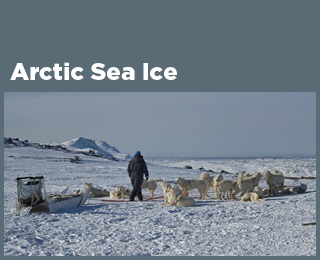 Climate Change Indicators: Arctic
Sea Ice Climate Change Indicators: Arctic
Sea Ice
This indicator tracks the extent, age, and melt season of
sea ice in the Arctic Ocean.
Key Points
September 2012 had the lowest sea ice extent ever recorded,
44 percent below the 1981–2010 average for that month.
The September 2016 sea ice extent was more than 700,000
square miles less than the historical 1981–2010 average for
that month (see Figure 1)—a difference more than two and a
half times the size of Texas. March sea ice extent reached
the lowest extent on record in 2015 and hit roughly the same
low again in 2016—about 7 percent less than the 1981–2010
average.
All months have shown a negative trend in sea ice extent
over the past several decades. The largest year-to-year
decreases have occurred in the summer and fall months.
Evidence of the age of Arctic sea ice suggests that fewer
patches of ice are persisting for multiple years (i.e.,
generally thick ice that has survived one or more melt
seasons) (see Figure 2). The proportion of sea ice five
years or older has declined dramatically over the recorded
time period, from more than 30 percent of September ice in
the 1980s to 9 percent in 2015. A growing percentage of
Arctic sea ice is only one or two years old. Less old
multi-year ice implies that the ice cover is thinning, which
makes it more vulnerable to further melting.
Since 1979, the length of the melt season for Arctic sea ice
has grown by 37 days (see Figure 3). Arctic sea ice now
starts melting 11 days earlier and it starts refreezing 26
days later than it used to, on average (see Figure 3). |
|
Background
Sea ice is an integral part of the Arctic Ocean. During the
dark winter months, sea ice essentially covers the entire
Arctic Ocean. In summer, some of this ice melts because of
warmer temperatures and long hours of sunlight. Sea ice
typically reaches its minimum thickness and extent in
mid-September, when the area covered by ice is roughly half
the size of the winter maximum. The ice then begins
expanding again.
The extent of area covered by Arctic sea ice is an important
indicator of changes in global climate because warmer air
and water temperatures are reducing the amount of sea ice
present. Because sea ice is light-colored, it reflects more
sunlight (solar energy) back to space than liquid water,
thereby playing an important role in maintaining the Earth’s
energy balance and helping to keep polar regions cool. (For
more information on the effects of surface color on
reflecting sunlight, see the Snow Cover indicator.) Sea ice
also keeps the air cool by forming a barrier between the
cold air above and the relatively warmer water below. As the
amount of sea ice decreases, the Arctic region’s cooling
effect is reduced, and this may initiate a “feedback loop”
whereby ocean warming caused by more absorption of solar
energy leads to an even greater loss of sea ice and further
warming.
The age of sea ice is also an important indicator of Arctic
conditions, because ice that has accumulated over many years
is generally thicker and stronger than younger ice. A loss
of older ice suggests that the Arctic ice cover is becoming
thinner. Evidence also suggests that the melt season has
become longer; the ice is starting to melt earlier in the
year and freeze later than it used to.
Changes in sea ice can directly affect the health of Arctic
ecosystems. Mammals such as polar bears and walruses rely on
the presence of sea ice for hunting, breeding, and
migrating. These animals face the threat of declining birth
rates and restricted access to food sources because of
reduced sea ice coverage and thickness. Impacts on Arctic
wildlife, as well as the loss of ice itself, are already
restricting the traditional subsistence hunting lifestyle of
indigenous Arctic populations such as the Yup’ik, Iñupiat,
and Inuit.
While diminished sea ice can have negative ecological
effects, it can also present commercial opportunities. For
instance, reduced sea ice opens shipping lanes and increases
access to natural resources in the Arctic region. |
|
About the Indicator
Figure 1 shows Arctic sea ice extent from 1979, when routine
monitoring by satellites started, to 2016. Sea ice extent is
defined as the area of ocean where at least 15 percent of
the surface is frozen. This threshold was chosen because
scientists have found that it gives the best approximation
of the edge of the ice. Data are collected throughout the
year, but for comparison, this indicator focuses on the
months when sea ice typically reaches its minimum and
maximum extent. September is typically when the sea ice
extent reaches its annual minimum after melting during the
spring and summer. Conversely, March is typically when sea
ice reaches its maximum extent after winter freezing. Data
for this indicator were gathered by the National Snow and
Ice Data Center using satellite imaging technology and data
processing methods developed by the National Aeronautics and
Space Administration.
Figure 2 examines the age of the ice that is present in the
Arctic during the one week in September that has the
smallest extent of ice. By combining daily satellite images,
wind measurements, and data from surface buoys that move
with the ice, scientists can track specific parcels of ice
as they move over time. This tracking enables them to
calculate the age of the ice in different parts of the
Arctic. Although satellites started collecting data in 1979,
Figure 2 only shows data back to 1983 because it is not
possible to know the full age distribution until the ice has
been tracked for at least five years.
Figure 3 shows the start and end dates of each year’s Arctic
sea ice melt season, starting in 1979. It is based on the
same satellite instruments as Figure 1. Here, the melt
season start date is defined as the date when satellites
detect consistent wetness on the surface of the ice and
snow; the end date is when the surface air temperature stays
consistently at or below the freezing point and ice begins
to grow in the open ocean.
Indicator Notes
Increasing air and ocean temperatures associated with
climate change are not the only factor contributing to
reductions in sea ice. Other conditions that may be affected
by climate change, such as fluctuations in oceanic and
atmospheric circulation and natural annual and decadal
variability, also affect the extent of sea ice. Determining
the age of ice is an imperfect science, as there are cases
where a small amount of older ice might exist within an area
classified as younger, or vice versa.
Data Sources
The data for Figures 1 and 2 were provided by the National
Snow and Ice Data Center. Data for Figure 1 are also
available online at:
https://nsidc.org/data/seaice_index/archives.html, while
Figure 2 is based on an analysis by the University of
Colorado and a map published at:
https://nsidc.org/arcticseaicenews/2015/10/2015-melt-season-in-review.
The National Snow and Ice Data Center produces a variety of
reports and a seasonal newsletter analyzing Arctic sea ice
data. Figure 3 data were provided by the National
Aeronautics and Space Administration and are available at:
https://neptune.gsfc.nasa.gov/csb/index.php?section=54.
Technical Documentation
Download related technical information PDF |
|
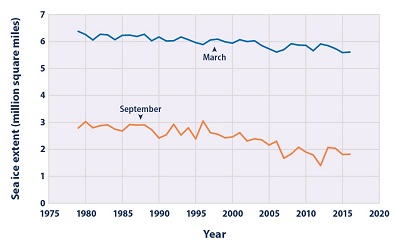 Figure
1. March and September Monthly Average Arctic Sea Ice
Extent, 1979–2016 Figure
1. March and September Monthly Average Arctic Sea Ice
Extent, 1979–2016
This figure shows Arctic sea ice extent for the months of
September and March of each year from 1979 through 2016.
September and March are when the minimum and maximum extent
typically occur each year.
Data source: NSIDC, 20164 |
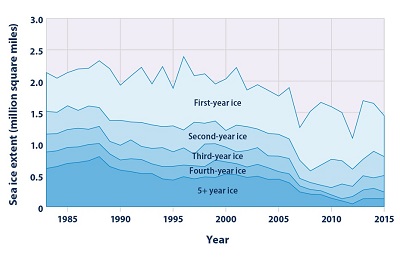 Figure
2. Age of Arctic Sea Ice at Minimum September Week,
1983–2015 Figure
2. Age of Arctic Sea Ice at Minimum September Week,
1983–2015
This figure shows the distribution of Arctic sea ice extent
by age group during the week in September with the smallest
extent of ice for each year. The total extent in Figure 2
differs from the extent in Figure 1 because Figure 1 shows a
monthly average, while Figure 2 shows conditions during a
single week.
Data source: NSIDC, 20155 |
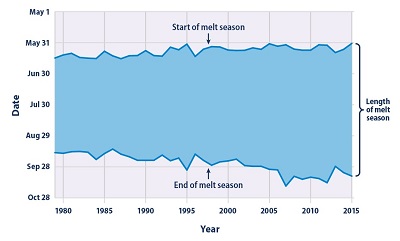 Figure
3. Arctic Sea Ice Melt Season, 1979–2015 Figure
3. Arctic Sea Ice Melt Season, 1979–2015
This figure shows the timing of each year’s Arctic sea ice
melt season. The shaded band spans from the date when ice
begins to melt consistently until the date when it begins to
refreeze.
Data source: NASA, 20166 |
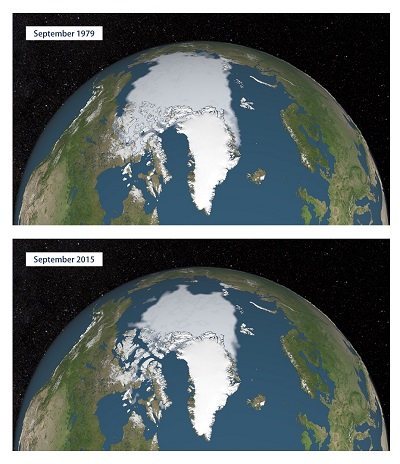 Dwindling
Arctic Sea Ice Dwindling
Arctic Sea Ice
Source: NASA, 20167 |
|
|
|
EPA Page |
|
This is the
EPA page for this topic. To see if the Trump
administration has changed the EPA page, simply click the
link and compare the information with this page. If you
notice changes were made to the EPA page, please post a
comment. Thanks. |
|
|
|
|
|
|
|
|
|
|
|
|
Additional Climate Change Information |
Climate Change and Carbon Dioxide
(Beginner - Listening,
reading)
A video lesson to
help with your understanding of climate change
and carbon dioxide.
The English is
spoken at 75% of normal speed.
Great English listening and reading practice. |
Carbon Dioxide and Climate Change
(Beginner - Listening,
reading)
A video lesson to
help with your understanding of carbon dioxide
and climate change.
The English is
spoken at 75% of normal speed.
Great English listening and reading practice. |
Environmental Group Warns Earth's Health at Risk
(Beginner - Listening,
reading)
A video lesson to
help with your understanding of climate change.
The English is
spoken at 75% of normal speed.
Great English listening and reading practice.
A report by the World Wildlife Fund looked at thousands of animal populations
and found they have dropped significantly in 40 years. |
Sea Levels Rising at Fastest Rate in 3,000 years
(Beginner - Listening,
reading)
A video lesson to
help with your understanding of climate change.
The English is
spoken at 75% of normal speed.
Great English listening and reading practice.
A group of scientists say sea levels are rising at record rates. Another group
found that January temperatures in the Arctic reached a record high. |
Capturing CO2 Gas Is Not Easy
(Beginner - Listening,
reading)
A video lesson to
help with your understanding of climate change.
The English is
spoken at 75% of normal speed.
Great English listening and reading practice.
Most scientists agree that carbon-dioxide gas is partly to blame for climate
change: rising global temperatures. But capturing the CO2 gas released by power
stations is costly and difficult. |
Growth, Climate Change Threaten African Plants and
Animals
(Beginner - Listening,
reading)
A video lesson to
help with your understanding of climate change.
The English is
spoken at 75% of normal speed.
Great English listening and reading practice.
Researchers believe Africa may lose as much as 30 percent of its animal and
plant species by the end of this century. |
|
|
|
|
Search Fun Easy English |
|
|
|
|
|
|
|
|
|
|
|
|
|
|
|
About
Contact
Copyright
Resources
Site Map |